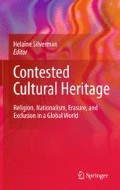Abstract
As we consider the contested landscape of cultural heritage, the facets elaborated in this volume are touch points for profitable discussion: social identity, political claims, national propaganda, ownership, respect, and interpretation. Yet, cultural heritage is fluid and constantly changing depending on the context of space and time. At the regional and global scale, the forces of homogeneity and unity reign, while at the national and local scales, heterogeneity and diversity prevail. With the growing world of tourism, cultural heritage has become a novelty realized through travel to the locale or its virtual substitute through print and moving media. Travel can be a positive opportunity that brings societies together to share common values of culture. But it also can generate tension when cultural values come into conflict. The case of the ancient Maya is significant on this point (Fig. 12.1).
Access this chapter
Tax calculation will be finalised at checkout
Purchases are for personal use only
References
Ali, Saleem H., ed. 2007. Peace parks: Conservation and conflict resolution. Global environmental accord: Strategies for sustainable and institutional innovation. Cambridge, MA: MIT Press.
Atran, Scott. 1993. Itza Maya tropical agro-forestry. Current Anthropology 34: 633–700.
Campbell, David G., Anabel Ford, Karen Lowell, Jay Walker, Jeffrey K. Lake, Constanza Ocampo-Raeder, Andrew Townesmith, and Michael Balick. 2006. The feral forests of the eastern Petén. In Time and complexity in the neotropical lowlands, ed. C. Erickson and W. Baleé, 21–55. New York, NY: Columbia University Press.
Ford, Anabel. 1998. El Pilar landscape: Gateway between two nations, management plan for El Pilar. Mesa Redonda II. http://www.marc.ucsb.edu/elpilar/management/Mesa_Redonda_II_Introduction.php (Accessed 13 September 2010) 18 pp. 2006. Adaptive management and the community of El Pilar: A philosophy of resilience for the Maya forest. In Of the past, for the future: Integrating archaeology and conservation, ed. N. Agnew and J. Bridgland, 105–112. Washington, DC: The Getty Institute.
Ford, Anabel, and Megan Havrda. 2006. Archaeology under the canopy: Imagining the Maya of El Pilar. In Tourism, consumption and representation: Narratives of place and self, ed. K. Meethan, A. Anderson, and S. Miles, 67–93. Wallingford, CT: CAB International.
Ford, Anabel, Melanie C. S. Smith, and John M. Morris. 2005. Community integration and adaptive management at El Pilar. In Archaeological investigations in the eastern Maya lowlands: Papers of the 2004 Belize archaeology symposium, vol. 2, Research reports in Belizean archaeology, ed. Jaime Awe, J. Morris, S. Jones, and C. Helmke, 459–470. Belmopan, Belize: Institute of Archaeology, National Institute of Culture and History.
Macri, Martha J., and Anabel Ford, eds. 1997. The language of Maya hieroglyphs. San Francisco, CA: Pre-Columbian Art Research Institute.
Sullivan, Paul. 1991. Unfinished conversations: Mayas and foreigners between two wars. Berkeley, CA/Los Angeles, CA: University of California Press.
Webster, David L. 2002. The fall of the ancient Maya: Solving the mystery of the Maya collapse. London: Thames & Hudson.
Author information
Authors and Affiliations
Corresponding author
Editor information
Editors and Affiliations
Rights and permissions
Copyright information
© 2011 Springer Science+Business Media, LLC
About this chapter
Cite this chapter
Ford, A. (2011). Afterword: El Pilar and Maya Cultural Heritage: Reflections of a Cheerful Pessimist. In: Silverman, H. (eds) Contested Cultural Heritage. Springer, New York, NY. https://doi.org/10.1007/978-1-4419-7305-4_12
Download citation
DOI: https://doi.org/10.1007/978-1-4419-7305-4_12
Published:
Publisher Name: Springer, New York, NY
Print ISBN: 978-1-4419-7304-7
Online ISBN: 978-1-4419-7305-4
eBook Packages: Humanities, Social Sciences and LawSocial Sciences (R0)

